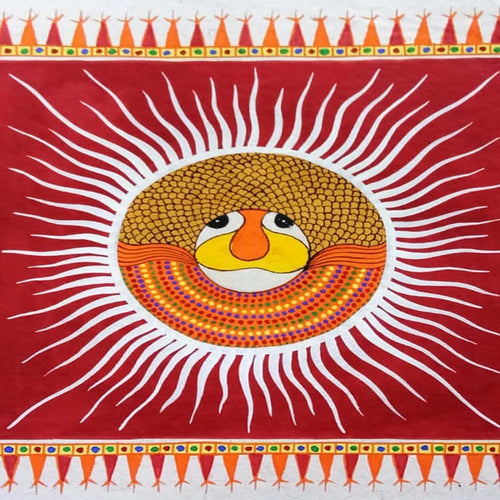Pithora painting is a vibrant and ritualistic art form practiced by the Rathwa, Bhilala, and Bhil tribes primarily in the states of Gujarat and Madhya Pradesh, India. These paintings are not just decorative; they are deeply rooted in the cultural and spiritual life of the community, often created as part of a ritual to invoke blessings from the deities. Recognized for their dynamic compositions, bold colors, and symbolic motifs, Pithora paintings serve as a living tradition that reflects the beliefs, myths, and daily life of the tribal communities. Each painting is considered a sacred offering, created with the purpose of fulfilling vows, seeking prosperity, or healing ailments.
Pithora paintings are rich with symbolic meaning and often depict a variety of themes centered around tribal mythology, folklore, and the natural world. Common motifs include horses, which symbolize the Pithora Baba and other deities, scenes of village life, animals, trees, and celestial bodies. The artwork typically narrates stories of creation, the relationships between humans and the divine, and the harmony between the tribespeople and nature. The paintings are filled with vibrant images of the sun, moon, and stars, representing the universe's interconnectedness and the cyclical nature of life. Each element in the painting serves a specific purpose and contributes to the overall narrative, making Pithora a deeply communicative and meaningful art form.
History
The origins of Pithora painting can be traced back centuries and are closely intertwined with the rituals and traditions of the Rathwa and Bhil communities. According to oral traditions, Pithora paintings began as a form of worship to appease and honor Pithora Baba, the chief deity believed to protect and bless the tribe. Historically, these paintings were created on the walls of village homes, particularly in the main room or the Pithora Ghar, which acts as a sacred space. The ritual of creating a Pithora painting involves elaborate ceremonies led by a 'Badwa' (tribal priest) who guides the painter, usually a male member of the tribe known as a 'Lakhara,' in the creation of the artwork. This art form has evolved over the years, adapting to changing times while preserving its core spiritual essence.
The style of Pithora painting is characterized by its use of bold, vivid colors and a distinctive linear quality. The paintings are usually executed on large, white-washed walls, creating a bright backdrop that enhances the vibrancy of the colors. The figures are rendered in a stylized manner, with simple yet expressive forms that capture the essence of the subjects. Pithora paintings are typically divided into three sections: the upper section represents the heavens, the middle section depicts the earth, and the lower section symbolizes the underworld. This tripartite division is not just artistic but also reflects the tribes' cosmology. The artwork is spontaneous and intuitive, with the painter often guided by the priest’s instructions rather than a preconceived plan, resulting in a dynamic and fluid composition.
Materials and Methods
The creation of Pithora paintings involves a collaborative and ceremonial process that begins with the preparation of the wall, which is first plastered with a mixture of mud, cow dung, and lime to create a smooth surface. The painting process itself is a ritualistic act, often accompanied by songs, dances, and offerings. Natural pigments sourced from the earth, minerals, and organic materials such as turmeric, vermilion, indigo, and rice flour are traditionally used to create the vibrant colors seen in Pithora art. Modern adaptations sometimes incorporate synthetic colors for convenience and durability. The figures and motifs are first outlined in bold lines, and then filled with vibrant hues, creating a visually striking and intricate tapestry of tribal life and belief.
Significance
Pithora paintings hold profound cultural and spiritual significance for the Rathwa, Bhilala, and Bhil communities. They are not merely decorative; each painting is a sacred offering, created as a fulfillment of a vow or as a plea for divine intervention in matters of health, prosperity, or protection. The process of creating a Pithora painting is as important as the artwork itself, involving the entire community in a shared act of devotion and celebration. Beyond their ritualistic value, Pithora paintings serve as a visual record of the tribes’ heritage, preserving their stories, beliefs, and connection to nature. In recent years, the art form has gained recognition beyond the tribal communities, appreciated for its raw aesthetic and cultural richness. Efforts to promote and sustain Pithora painting include workshops, exhibitions, and collaborations with contemporary artists, ensuring that this vibrant tradition continues to thrive and inspire future generations.
FAQs
Are Pithora paintings purely decorative?
No, Pithora paintings are not purely decorative. They are deeply spiritual and serve as a form of communication with the divine. Each painting is considered a sacred offering, created with specific intentions such as honoring a vow, seeking blessings, or invoking protection.
Can Pithora paintings be found outside of tribal homes?
Yes, Pithora paintings have gained recognition beyond tribal communities and are featured in exhibitions, cultural festivals, and art galleries. They are appreciated for their artistic and cultural value and have been incorporated into contemporary art spaces, helping to raise awareness of this traditional craft.
How can one support Pithora painters and preserve this art form?
Supporting Pithora artists can be done by purchasing their artworks, participating in workshops, and promoting awareness of the craft.
